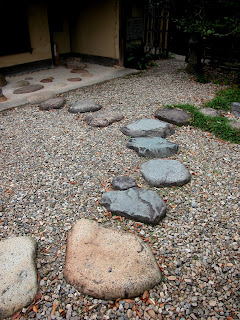わび
Wabi (usually written in hirigana as above, but also sometimes
written with the character 侘 ) is one of the crucial aesthetic
terms in Japanese culture, and fundamental to an understanding of any of the
arts, including gardens. It may be particularly applied to the world of the Tea
garden, though its scope is clearly wider than being restricted to a single
expression of garden art. The form of Tea ceremony developed by the master Sen
no Rikyu is often referred to as 'wabi cha', the tea of wabi. It is a term
that is closely associated with another term, sabi (さび).
Sabi refers to the quality of been worn or well used, the 'not newness' of
something, and is particularly associated with patina and the feeling of that
comes from something that is well used. The term sabi will
be explored in another blog post later.
Wabi may be translated as 'loneliness',
'poverty', 'subdued taste', or 'simplicity'. All of these terms offer some
guide to the meaning of the concept without actually defining it absolutely.
All of these tentative definitions must be understood in the spiritual or
metaphysical sense. The 'loneliness' that is referred to, is a sense of
detachment from the everyday world, both in the manner of a physical
separation, as well as a separation that is brought about by a conscious act of
intention. It is not a detachment of unsociability, rather a conscious
withdrawing from the hustle and bustle, in order to seek out a space wherein
the mind and spirit may achieve a sense of peace, through a lessening of
distraction. Tea is after all a social occasion that will be shared with
others. Likewise the appreciation of the garden is not by definition a solitary
activity, but one that may be shared and enriched by the presence of others of
a like mind. There is a long tradition of the 'hermit-poet' in Japanese
culture, though these were not by any means people who were driven to such a
state by a feeling of malice toward their fellow men, rather people who sought
out quiet places in order to sharpen their perception and thereby be capable of
seeing and understanding deeper the human condition. Thus the garden may be
seen to be a place that offers refuge, and the material composition of the
garden a path toward that quiet space, which ultimately lies within. The poet
Ryokan expresses it this way;
"Truly, I love this life of seclusion.
Carrying my staff, I walk toward a friend's cottage.
The trees in his garden, soaked by the evening rain,
reflect the cool, clear autumnal sky.
The owners dog comes to greet me:
Chrysanthemums bloom along the fence.
These people have the same spirit as the ancients;
An earthen wall marks their separation from the world.
In the house volumes of poetry are piled on the floor.
Abandoning worldliness, I often come to this tranquil place-
The spirit here is the spirit of Zen."
Likewise
the 'poverty' that is spoken of is not the poverty of destitution, rather is is
a deliberate turning away from the world of ostentation and glamour. It is a
recognition that the generation and accumulation of wealth in this world is a
temporary experience that has no depth in the metaphysical sense. To the
Buddhist or Taoist, reality lies in the recognition of the non-absolute (
'emptiness' ) as the only constant. When everything is in a state of constant
change then the path toward enlightenment lies in detachment from acquisition
and accumulation of material objects, as these ultimately have no true reality.
This has a bearing on the form of the garden, whereby the intention is to
present the garden free of ostentation ( ego ) and glamour, the 'hands of the
garden-creator' are hidden. Nature itself remains the prime source of
inspiration of motif and the ultimate model for garden builders, the
garden-creator is simply the facilitator, working as a medium through which the
garden form will emerge.
Likewise
the interpretation of wabi as 'subdued taste' or 'simplicity' may be understood in the light of
what has been set out above. The materials chosen for the garden are of the
simplest kind, earth, stone, plants and water, presented in a manner that resolves
to express something of the spirit of the landscape, rather than being a
detailed reconstruction of landscape scenery. Naturally we see here an
influence of Zen Buddhism, in particular the concept of presenting those
elements that are deemed absolutely essential and avoiding all extraneous
material. By this process of reduction there is an allowance made for the
imagination of the garden viewer to have maximum scope for involvement in
recreating within his own heart the landscape scene that is being presented.
The potential for distraction from this course is thereby minimised, through
the discipline of 'subdued taste' that a greater freedom of expression may be
acquired.
It is in
these ways that the concept of wabi may be understood to have a strong bearing
on the creation and appreciation of the garden as a whole. Though wabi is
associated in particular with the world of Tea, its resonance goes far beyond
that particular aspect of the Japanese garden tradition. There is a poem by
that is much beloved by the Tea masters for its capacity to capture the essence
of wabi.
All around, no flowers in bloom are seen,
Nor blazing maple leaves I see,
Only a solitary fisherman's hut
On the sea beach, in the twilight of this
autumn eve.
Lord Teika 1162-1241





No comments:
Post a Comment